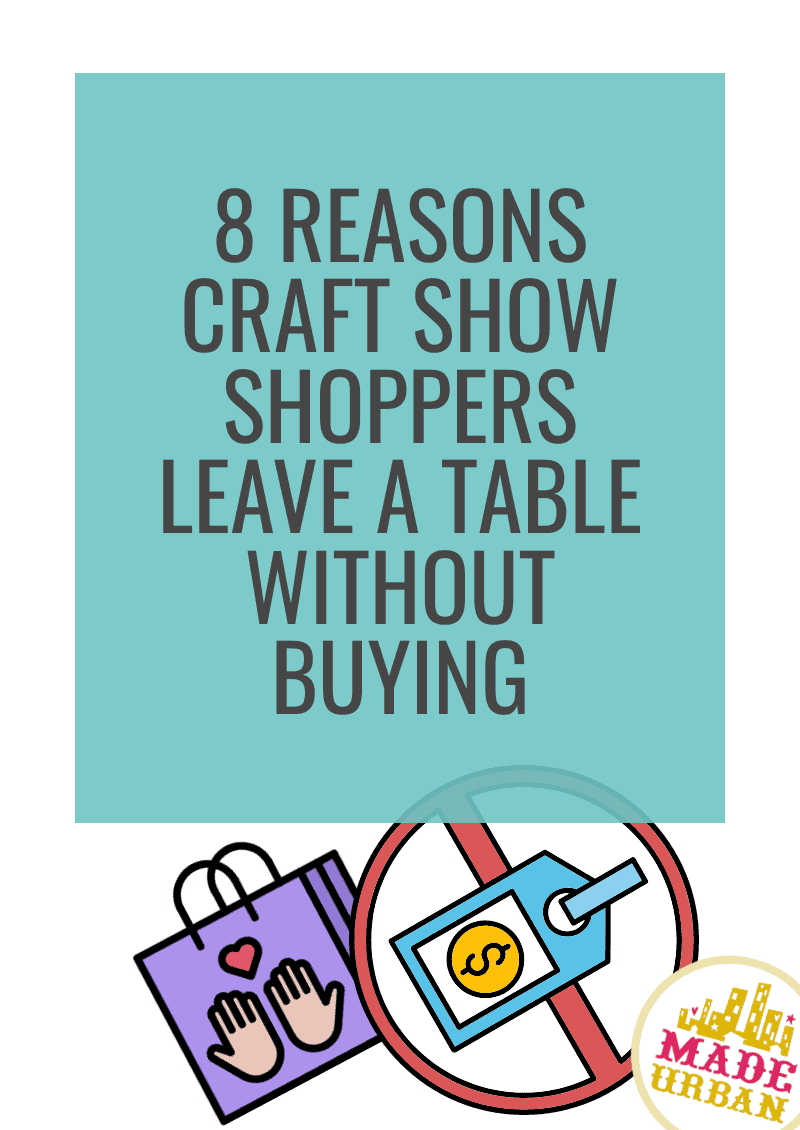8 Reasons Craft Show Shoppers Leave a Table without Buying
If a craft show shopper stops at your table, they’re telling you they have an interest in your products.
You’ll never get every shopper to stop at your table, and that’s perfectly fine.
As beautiful as a vendor’s products might look, if they’re selling kid’s tutus or bibs, I’m not going to stop because I have no need for those items.
But when someone does stop at your booth, it’s your sale to lose.
Here are 8 mistakes to avoid to ensure you turn more of those shoppers into customers.
1 – Prices aren’t listed
This is a popular complaint from craft show shoppers and at a busy craft show, and many don’t want to wait for the vendor to be free to be able to find out the price of an item.
A shopper also doesn’t want to ask multiple times how much something is as they pick up different items.
A table with limited items may be able to use a couple of price list signs.
For example, a price list sign stating the price for lotion, bars of soap, and bath bombs makes it easy for shoppers to determine what’s what and match the price to it.
On the other hand, if a craft show table has dozens of different products, a price list would be too confusing for shoppers.
If it’s not ideal to put a price sticker or tag on individual items, be sure to group like items together on your table and use several small signs to communicate prices.
2 – Can’t make up their mind
When I’m shopping at craft shows and I can’t make up my mind, and there are several other shoppers waiting to look at items I’m in front of, I ask for a business card so I can shop online later.
But many times, I find another vendor to buy from that day, forget to visit the website at a later date, and/or don’t want to pay the shipping fees when I do get around to visiting their website.
There will always be indecisive shoppers who need more time to think about a purchase.
However, if you offer too much selection and too many options, you’re making it harder for any shopper to find something they love and buy.
3 – Not enough selection
Although you don’t want so much selection that it’s too much for shoppers to take in or makes it too hard for them to make a purchasing decision, you also don’t want so little selection that a shopper can take it all in with a glance.
Shoppers need some selection to browse through. And you also want products that can work together.
I always think about the last holiday craft show I went to as a shopper.
I needed to purchase a gift for a white elephant gift exchange and had to spend around $50.
A soap vendor was selling beautiful and unique soaps. They were in soft earth-tone colors and had dried flowers “baked” into the top.
But that’s all they had.
I couldn’t buy 5+ bars of soap to meet my budget.
But I also didn’t want to buy this unique bar of soap and then wander around and try to find other items that fit the style, scent, and theme.
If that vendor also had bath salts, lotion, bath bombs or other items I could buy with the soap, I would have spent my full $50 budget with them.
You don’t need to go crazy trying to offer something for everyone. But do think of your target market and the options they might want to see or the segments within that market you can appeal to.
4 – Out of budget
Your products should be priced to ensure you’re covering all your costs (here are commonly ignored craft show costs) and making a profit. (Here’s the right way to price your products).
So it’s not up to you to lower your prices to fit someone’s budget.
However, you may want to consider having entry-level and add-on products that are lower priced so that a shopper who loves your main products but is on a tighter budget, can still walk away with something.
For example, a craft show table selling boho-style dresses for little girls may also offer scrunchies, headbands and handkerchief scarfs in the same styles/materials.
Don’t lower your prices or squeeze your profits but do try to offer one or two products that fit within your target market’s definition of low, medium, and high priced.
5 – Vendor is too pushy or too standoffish
Many shoppers will decide not to buy (perhaps out of spite) if they feel the vendor is uninterested in their patronage.
A vendor who ignores shoppers while they scroll their phone, talk to booth neighbours, or give all their attention to another shopper is likely to lose business.
On the other hand, you don’t want to be too pushy. Let shoppers know you appreciate them stopping by your table, share your main sales pitch, ask them to let you know if they have any questions, and then, for the most part, let them shop.
6 – Lack of payment options
Most craft show shoppers want to pay using cash or a credit/debit card.
Be sure to have lots of small bills so you can accept cash, and sign up for a card reader such as Square so those who don’t have cash can pay with a chip or pin card, contactless card, Google Pay, etc.
7 – They had to wait too long
When shoppers linger at your table too long, and people see that things aren’t moving, they’ll give up and walk away.
If your product selection is overwhelming because there are too many types of products or too many options to choose from, people are going to take a while to make a choice.
And that can clog up your craft show table.
You also want to streamline your sales process.
- Sales pitch – Shoppers don’t need to know every detail about your products; simply highlight the most important ones that influence buying.
- Shoppability – Organize your display in a way that makes it easy for people to shop and easy for you to help them shop from the other side of the table. For example, a jewelry vendor should display their pieces the work together (e.g. earrings, necklaces, and rings that can be worn together) in the same area so a shopper doesn’t need to reach or move across the table to mix and match.
-
Checkout – When someone is ready to buy, be sure you move them to zone 3 where they can browse small add-on items while you clip tags, wrap items, and tally totals while being out of the way of your main items (here’s how to set up zones in your craft show display). Stay organized behind your table so you can quickly wrap purchases and complete transactions. You might:
- pre-stuff shopping bags with business cards and coupons.
- have a calculator handy to quickly tally totals.
- get familiar with your point of sale system (e.g. Square reader) so you’re efficient with it.
8 – Craft show is too crowded
Although it’s out of your hands, it’s something to keep in mind when choosing which craft shows to apply to.
If the event space is too small, the shopping hours are too short, the booths/tables are too crunched together, or the aisles are too small, it can end up frustrating shoppers (here are 7 things that frustrate craft show shoppers).
Although they may love what you’re selling, they may decide to cut their shopping short if they keep getting bumped by people and strollers while stopped at your table.
A busy craft show full of shoppers is a great thing! But hopefully the event organizer has planned accordingly and hasn’t tried to cram too many booths or too many shoppers into the venue.
Not every shopper will be your customer
Don’t be discouraged if more shoppers don’t buy than do. That’s normal.
Average conversion rates are around 2% – 3% online and 20% – 30% for brick-and-mortar.
That means, on average, if 100 people walk into a store, only 20 or 30 of them end up buying.
Craft shows are closer to a brick-and-mortar store than an online store, but conversion rates can fluctuate depending on the type of shoppers the event attracts, how appealing a vendor’s products are to that type of shopper, time of year, price points, etc.
And not every shopper can be your customer. A small business can’t appeal to everyone. Choose your target market, create products and a display that appeals to them, and don’t be discouraged by people who decide to skip your booth; they’re not a fit for your business.
Feel free to share any reasons you leave a table without buying when you’re the shopper (instead of the vendor).


Hey, I’m Erin 🙂 I write about small business and craft show techniques I’ve learned from being a small business owner for almost 2 decades, selling at dozens of craft shows, and earning a diploma in Visual Communication Design. I hope you find my advice helpful!
